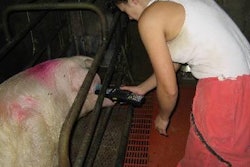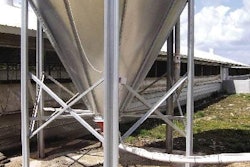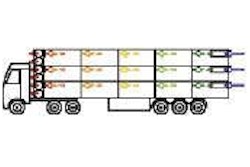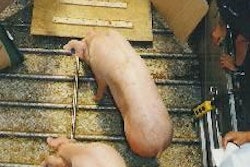
Few other people can match Masaru Shizawa's claims to be a major voice in Japanese pig production. He is a producer, owning 3000 sows, who has been involved in the pig industry in Japan since 1965. Mr Shizawa has also been instrumental in guiding the focused development of the national pork sector, influencing policy on producers' behalf. Currently the chief director of the Japan Pork Producers Association, he also represents some producer organisations in his capacity as chief director of the Kanagawa Prefecture swine association.
We should remind you that Japan each year has an on-farm inventory of some 9.5 million pigs including over 900 000 sows and that these animals are found on about 9000 units. The prefecture (administrative district) of Kanagawa contains approximately 10% of the national herd, mainly on 100 farms.
Looking across the whole of Japan, Masaru Shizawa raises a number of subjects relating to the country's current pig production including market deregulation, environmental measures and food waste recycling. Soon into our interview he also points out that producing pigs remains a big business. The annual output of all forms of agriculture in Japan is valued at about 9 trillion Yen, he notes. Livestock production accounts for some 28% of that total, at an estimated 2.5 trillion Yen. The pig sector alone has a 21% share of the livestock valuation by recording annual sales of about 530 billion Yen.
However, Mr. Shizawa declares that the Japanese livestock industry in general is enduring severe circumstances that demand understanding and co-operation among the people. Organising the industry to meet present and future challenges becomes ever more important.
"Unless we become more organised, we as pig producers in this country will not be able to compete internationally," he insists. Competitive pressures on the Japanese producer will increase through the opening up of the domestic market even while working within the WTO agreement on trading in agricultural products. In April 2005 a Japan-Mexico economic partnership agreement (JMEPA) was started which meant that the tariff rate on pork imported from Mexico would be reduced by half (from 4.3% to 2.2%) in 5 years and the ceiling on imports would be raised over the same period from 38 000 tons up to 80 000 tons. Pork was excluded from a similar EPA negotiated with Malaysia to take effect in July 2006, but it formed part of the parallel negotiations held with Thailand and the Philippines. More recently, pig producers have been watching the Japanese government negotiating along similar lines with Chile, South Korea and the Asean trading bloc of countries in south-east Asia and also with Indonesia.
Japan's car and steel industries had put considerable pressure on the Tokyo officials to reach an agreeable solution over exports to Chile. But when the outcome of the Japan-Chile negotiations became known in September, it was clear that the previous accord with Mexico had provided a template for setting the tariff allocation on imports of Chilean pork.
"We need more power," Mr. Shizawa says. "The producers themselves should invest in funds through the checkoff to further strengthen their organisation in this country. The pig industry must be self-supporting to undertake its own development, we can no longer rely on subsidies."
A particular challenge he identifies for Japanese pigmeat to be more competitive is the recognition of its currently low levels of productivity. With approximately 907 000 sows in the country today, he explains, in theory over 18 million slaughter pigs should be marketed annually. On average a domestic slaughterhouse operates for 235 days per year, so the theory also says a total of 77 191 finishing pigs should be shipped for slaughter each day.
"In fact the daily shipments of pigs in this country are considerably smaller than that. The number does not reach even 16 million pigs per year, or 68 085 per day. Actual shipments are averaging about 12.8 million pigs annually. That works out at only 14.1 pigs per sow/year. It is time for us to recognise how poor our productivity has become and to start doing something about it.
"Additionally, we should think how a safer pork can be produced and distributed, bearing in mind that Japan now has a positive-list system for agricultural inputs in foods. The health of the pigs must be considered as well. Freedom from Aujeszky's disease/pseudorabies is very important. So too is the promotion of a regional system for preventing epidemics. Unless we achieve these goals, the Japanese pig industry cannot be kept going."
Feeding practices then enter the conversation. Mr. Shizawa reminds us that pig production can perform a valuable service in recycling waste foods from catering establishments by processing it into feeds for our animals. Although it is a viewpoint that may differ from the opinion held by the Japanese ministry of the environment, he comments, this food material is an undoubted resource provided that its quality and safety are assured.
"They have been doing this in Europe for years, using recycled biomass as an organic feedstuff for delivery through liquid feeding systems. I see that there is now a gradual increase in the number of pig units in Japan which introduce and utilise European-style liquid feeding systems from Europe. The movement to manufacture ethanol from corn also became strong recently and the rise in price of the feed grains could strike a blow against Japanese livestock production in the future. In the meantime, however, food waste recycling should be promoted, either processed into feed or turned into compost if it is not suitable for feeding."
"We have to do everything we can to reduce our costs of producing pigs," Mr Shizawa continues. "A further decrease of the production cost is indispensable. There are opportunities to exploit in the joint purchasing of feeds; for example, in the tariff allocation system for corn and in effective use of the SBS (simultaneous buy-and-sell) method of buying wheat from overseas.
"Moreover, the harbour fee for unloading imported feed materials at a Japanese port is about 24 500 Yen on average. That is about 4 times the fees charged in other parts of the world. The pig production cost in Japan cannot fall unless this charge is reduced.
"The opportunities for savings do not end with import arrangements and the efforts of the feed manufacturers. Further costs can be saved at farm level such as by having more flexible preparations for receiving compound feeds so that the transportation cost from the mill is decreased, to add to the savings possible through liquid feeding and recycling of food wastes.
"At the same time we must not lose sight of the extra expenses due to disease. Each year in this country, between 3-5 million of the pigs born cannot be shipped to market because they have suffered health problems. The loss has been calculated to total 50 billion Yen per year or 10 000 Yen per pig. That must not be allowed to continue.
"Do not expect the wholesale price of domestic pork in Japan to move up steadily in the months and years to come, it is not possible. The only way of maintaining our margins will be by reducing our costs. But we must not lose sight of other necessities, not least addressing the issue of animal welfare. Obviously we need to think seriously about the future of the pig industry of Japan. That does not just mean paying attention to the consequences of matters such as market deregulation and environmental problems. As pig producers we are entitled to have our own opinions, but we must listen to the consumer!"PIGI

















